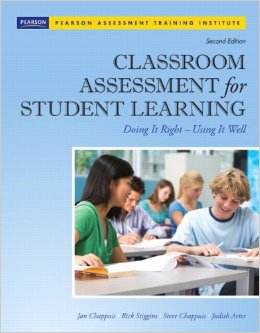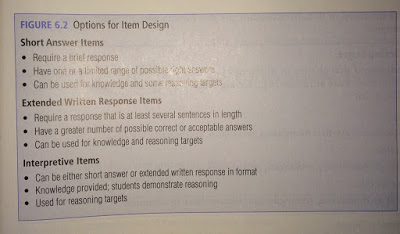Classroom Assessment Chapter 6

To help us work towards our school goal of improving our understanding and practice of assessment, my principal has provided our staff with a copy of Classroom Assessment for Student Learning: Doing it Right – Using it Well, by Jan Chappuis, Rick Stiggins, Steve Chappuis, and Judith Arter. As I make my way through the book, I will be summarizing my learning as a means of organizing my thoughts and getting clarification on particular ideas.
 |
| Classroom Assessment for Student Learning Cover. (Accessed 2016). Uploaded to Amazon; Pearson Education. Available online at: https://www.amazon.ca/Classroom-Assessment-Student-Learning-Doing/dp/0132685884 |
Chapter 6 – Written Response Assessment
* see Chapter 4 for the most appropriate times to use selected response assessments
* before you begin, use the assessment development cycle and make a blueprint (Ch. 4)
Developing the Items
1 ) Knowledge Questions
– provide context
– specifically state what you want students to explain
– point the way to an appropriate response
(ex) a mark breakdown by concept
2 ) Reasoning Questions
– same steps as knowledge questions but specify the kind of reasoning to be used
3 ) Interpretive Questions
* provide a passage, table, chart, map, etc and students use reasoning to answer questions about it
– same steps as knowledge questions but explain the provided item and specify the kind of reasoning to be used
 |
| Chappius, et al. (2012). Figure 6.2 Options for Item Design. Classroom Assessment for Student Learning, pg 175. |
Scoring Guide Options
1 ) Task-specific List
– list all possible correct options & info about how points are awarded
– lists should be shared to help point the way to a response BUT don’t be so specific that you give away answers
2 ) Task-specific Rubric
– a rubric that describes features of quality as they appear in a single task
– can’t be given to students because it gives away the answer
– used for conceptual understanding
– how to make one:
– create a proposition for the understanding
– identify partial understanding
– identify misunderstandings
– determine how many levels the rubric should have and assign points
3 ) General Rubric
– a rubric that describes features of quality as they appear across items/tasks
– can be given to students to guide them to an answer
– use the same steps as a task-specific rubric but remain general
Checking the Assessment for Quality
– students should be able to finish in the provided time frame
– make sure multiple students aren’t asking for clarification on specific questions
How to Use Written Response as Formative Assessment
– provide samples and let students score them
– provide a list of misconceptions and have students work towards correcting them
– make rubrics to provide feedback
_____________________________________________
I WANT TO KNOW:
Many teachers often have a section in their written response rubrics that covers grammar and spelling. Based on my understanding of the reading, any rubrics should address the learning target only so any class other than English wouldn’t have grammar or spelling as a learning target.
Should you still include grammar and spelling as an area of assessment in a rubric?
Please leave your thoughts below 🙂